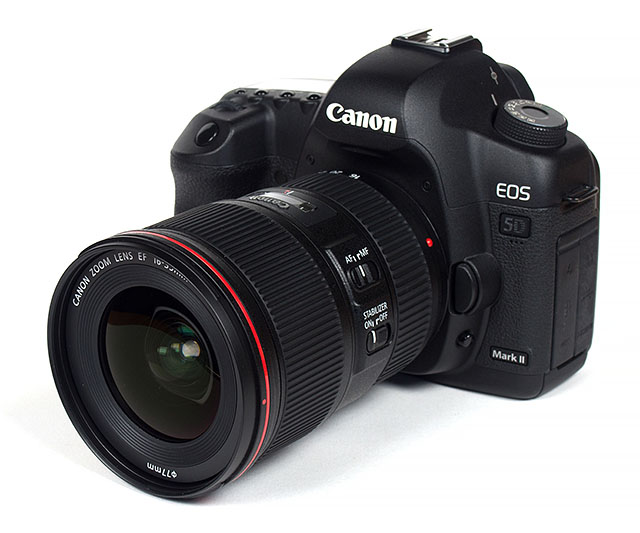|
Canon EF 16-35mm f/4 USM L IS - Review / Lens Test Report |
|
Lens Reviews -
Canon EOS (Full Format)
|
|
Page 1 of 3

Review by Klaus Schroiff, published July 2014
Introduction
Canon is offering some of the very best lenses around. However, this statement applies mostly to tele lenses. To date the situation wasn't all that glorious especially in the ultra-wide segment. Admittedly the Canon TS-E 17mm f/4 is an exception to the rule but this is hardly a mainstream lens. Canon's "prosumer" zoom lens is (was) the Canon EF 17-40mm f/4 USM L which dates back to the film era. On paper it's certainly interesting regarding its comparatively long range and, maybe even more so, a fairly attractive pricing. Unfortunately it is a rather poor performer with soft corners in the critical lower portion of the zoom range. It took Canon quite a while but they have just released the successor - the Canon EF 16-35mm f/4 USM L IS. So Canon sacrificed quite a bit of range at the long end in favor of a 16mm setting. Whether you like this or not is, of course, a matter of personal taste but honestly we would have preferred the old range. However, the new lens also adds an image stabilizer - a first for Canon in this lens class. Regarding a potential 4 f-stops "gain", it has actually a better low light potential (for static scenes) than its bigger cousin - the EF 16-35mm f/2.8 USM L II. Unfortunately this comes literally at a price - the EF 16-35mm f/4 USM L IS is almost as expensive as the f/2.8 lens. A trend that we have already seen with the Canon EF 24-70mm f/4 USM L IS vs the EF 24-70mm f/2.8 USM L. It is also just as heavy and big as the f/2.8 lens.
 The build quality of this lens is very high just as you would expect it from a Canon L lens. No wobbling whatsoever and smooth controls - almost perfect. That being said ... the middle portion of the lens body appears to be made of plastic rather than metal. While we don't have any objections with this per se, it feels somewhat inappropriate in such a pricey lens. The lens is also designed to survive in harsh conditions with a sealing against dust and moisture. The outer length of the lens remains constant although the inner lens tube moves a little according to the zoom setting. Needless to say - the front element does not rotate during focusing or zooming operations.
The build quality of this lens is very high just as you would expect it from a Canon L lens. No wobbling whatsoever and smooth controls - almost perfect. That being said ... the middle portion of the lens body appears to be made of plastic rather than metal. While we don't have any objections with this per se, it feels somewhat inappropriate in such a pricey lens. The lens is also designed to survive in harsh conditions with a sealing against dust and moisture. The outer length of the lens remains constant although the inner lens tube moves a little according to the zoom setting. Needless to say - the front element does not rotate during focusing or zooming operations.

The lens has a ring-type USM drive based on a front-focusing system resulting in an extremely fast AF speed. Typical for ring-type USM lenses full-time manual focusing is always possible in one-shot AF mode. Now as far as the image stabilizer is concerned - it works as specified although we have the impression that it costs a bit in image quality when activated.
| Specifications | Canon EF 16-35mm f/2.8 USM L II | Canon EF 16-35mm f/4 USM L IS | Canon EF 17-40mm f/4 USM L |
|---|
| Optical Construction | 16 elements in 12 groups
(3x asph. & 2xUD elements) | 16 elements in 12 groups
(3x asph. & 2xUD elements) | 12 elements in 9 groups
(3x asph. & 1xSUD elements) |
| Aperture Blades | 7 (circular) | 9 (circular) | 7 (circular) |
| min. focus distance | 0.28m
(~1:4.5 @ 35mm) | 0.28m
(~1:4.3 @ 35mm) | 0.28m
(~1:4 @ 40mm) |
| Dimensions | 89x112mm | 83x113mm | 84x97mm |
| Weight | 640g | 615g | 475g |
| Filter size | 82mm (non-rotating) | 77mm (non-rotating) | 77mm (non-rotating) |
| Hood | included, petal-shaped | included, petal-shaped | included, petal-shaped |
| Other features | gel filter slot (rear), sealing | gel filter slot (rear), sealing, IS | gel filter slot (rear), sealing |
|